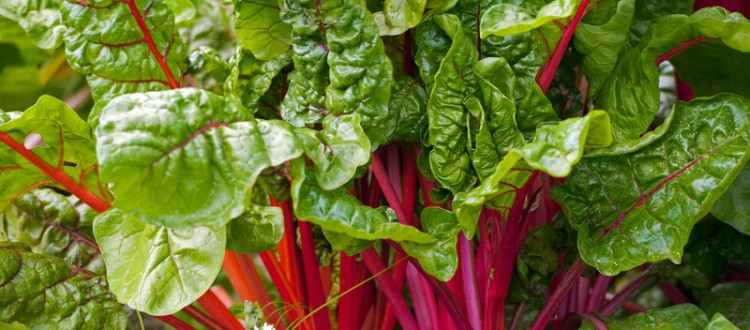Swiss Chard
Swiss Chard (beta vulgaris cicla), a leafy green annual also known as spinach-chard or silverbeet, originated in the Mediterranean region, but was given its botanical name by a botanist to distinguish the chard plant from another similarly named plant and does not represent the origin of the plant. The Greek philosopher and scientist, Aristotle, wrote about the health benefits of chard in the fourth century B.C. Chard was considered a medicinal plant by the Romans and used for fevers and digestion.
A member of the beet family, Swiss chard comes in a rainbow of colors. In fact, beet tops and chard leaves have a very similar flavor and texture. Both the leafy greens and the stalk of the Chard plant are edible, with variations for texture and flavor across the different colors. White stalks tend to be the most tender.
A Powerhouse of Nutrition
According to Nutrition and You, chard is second only to spinach in nutritional value and health benefits due to its high level of anthocyans and fiber, as well as vitamins and minerals. Swiss chard, like spinach, is the store-house of many phytonutrients that promote good health and have disease prevention properties. And here are more nutritional facts from Nutrition and You about chard:
- Chard is very low in calories (19 calories per 100g fresh, raw leaves) and fats, recommended in cholesterol controlling and weight reduction programs.
- Chard leaves are an excellent source of antioxidant vitamin, vitamin C. Its fresh leaves provide about 33% of recommended levels per 100g. As a powerful water-soluble antioxidant, vitamin C helps remove free radicals and reactive oxygen species (ROS) from the human body through its reduction potential properties. Research studies suggest that regular consumption of foods rich in vitamin C help maintain normal connective tissue, prevent iron deficiency, and also help the human body develop resistance against infectious agents by boosting immunity.
- Chard is best vegetable sources for vitamin K; 100g provides about 700% of recommended intake. Vitamin K plays a vital role in bone health by promoting osteotrophic (bone formation and strengthening) activity. Adequate vitamin-K levels in the diet help limiting neuronal damage in the brain; thus, has established role in the treatment of patients suffering from Alzheimer’s disease.
- It is also rich source of omega-3 fatty acids; vitamin-A, and flavonoids anti-oxidants like ß-carotene, a-carotene, lutein and zea-xanthin. Carotenes convert to vitamin A inside the body.
- It is also rich in B-complex group of vitamins such as folates, niacin, vitamin B-6 (pyridoxine), thiamin and pantothenic acid that are essential for optimum cellular metabolic functions.
- It is also rich source of minerals like copper, calcium, sodium, potassium, iron, manganese and phosphorus. Potassium is an important component of cell and body fluids that helps controlling heart rate and blood pressure by countering effects of sodium. Manganese is used by the body as a co-factor for the antioxidant enzyme, superoxide dismutase. Iron is required for cellular oxidation and red blood cell formation.
How to Plant
Chard prefers a loamy soil that is well dug and fertile, with a pH of 6.0 or more. It performs best in cool temperatures, however it has some heat tolerance and can be planted thoughout the summer in some areas that aren’t too hot. Chard can be sown in temperate climates from March though September. Transplants can be set out after danger of frost has past. Plants can be set out well into October or November in some coastal climates.
Set plants at about 4-6 inches apart, babies can then be thinned (and consumed!) ultimately to a 10-16 inch spacing.
Fertilizing
When the plants are 6 inches tall, they can be side dressed with a balanced fertilizer.
Harvesting
Mature leaves can be snipped from the outer side of the plant, while taking care not to damage the tender inside growing tip. Chard that is properly maintained can stand easily for 6-8 months, but eventually the seed stalk will form and the plant will go to seed. For a continuous harvest, plant successively during the spring and Fall.
Recommendations for Use
- To remove grit or soil between the leaves, immerse greens in a bowl of cool water.
- Store unwashed chard in a plastic bag inside the refrigerator for up to 5 days.
- Chard can be eaten raw, but cooking chard makes it sweeter and less bitter.
- Blanch chard (dip leaves in boiling water for a few seconds, remove and plunge into ice bath) to retain the vibrant colors — then add it to soups or stir-fries.
- Avoid using aluminum pans when cooking chard. Chard contains oxalates (acids) that react with the metal and cause the pot to discolor.
Recipes
Italian Sausage, Summer Squash and Wild Rice Stuffed Chard (Note: I like the vegetarian version, too, and like to use golden raisins.)

